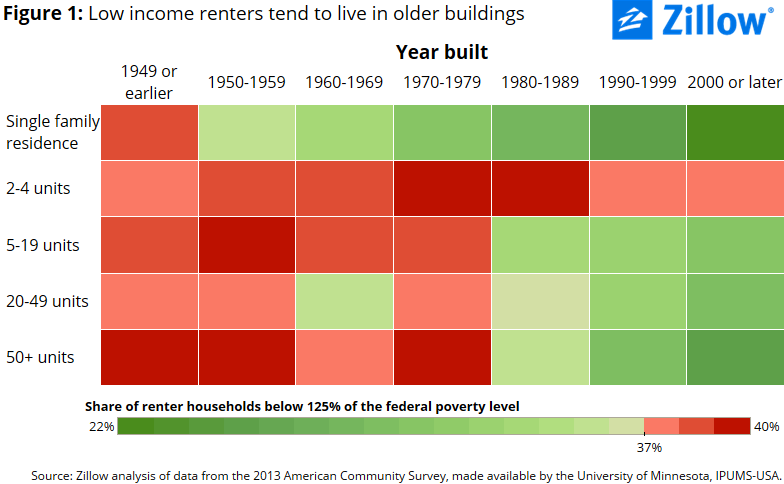- Renters are almost three times more likely than owners to have low incomes.
- Low-income households are more likely to live in older single-family residences, older large apartment buildings and in low-rise, multifamily structures of all ages.
Once concentrated in rural communities and in dense urban cores, the renting poor are now increasingly visible in historically relatively affluent suburban communities that experienced very sharp downturns and widespread foreclosures during the Great Recession.[1]
A generation ago, low-income renters lived primarily in antiquated, rural, single-family residences and large, urban, multifamily developments. Today, in the aftermath of the housing boom and bust, low-income renters are more likely to reside in the kinds of low-rise, low-density, multifamily structures that dot the peripheries of many suburbs.
 While roughly one-third (36 percent) of all American households rent, more than two-thirds (68 percent) of America’s low-income households are renters. [2] Renters are about three times more likely than homeowners to have low incomes, a ratio that has slowly improved since 2010 – due in part to the growing population of renters overall – but remains above where it stood a generation ago. In 2013, about 26 percent of renter-occupied households had low incomes, compared to 9 percent of owner-occupied households.
While roughly one-third (36 percent) of all American households rent, more than two-thirds (68 percent) of America’s low-income households are renters. [2] Renters are about three times more likely than homeowners to have low incomes, a ratio that has slowly improved since 2010 – due in part to the growing population of renters overall – but remains above where it stood a generation ago. In 2013, about 26 percent of renter-occupied households had low incomes, compared to 9 percent of owner-occupied households.
Zillow examined low-income households across structure type and structure age (figure 1). We noticed several trends:
- Renters of single-family residences (SFRs) are far less likely than other renters to have low incomes.
- There are more low-income SFR renters in older homes relative to other SFR renters.
- Among renters in more traditional apartment buildings (structures with five or more units), low-income families tend to be concentrated in older apartment buildings.
- Among renters of duplexes/triplexes/quadplexes, low incomes are pervasive, regardless of structure age.
 Comparing the distribution of low-income rental households across structure types and ages with the overall distribution of renter households (figure 2), it is clear that low-income households are overrepresented in three types of structures: Older, single-family residences; low-rise/low-density multifamily structures, of all ages; and larger, older apartment buildings. Low-income households are particularly underrepresented in newer single-family homes, and newer large apartment buildings.
Comparing the distribution of low-income rental households across structure types and ages with the overall distribution of renter households (figure 2), it is clear that low-income households are overrepresented in three types of structures: Older, single-family residences; low-rise/low-density multifamily structures, of all ages; and larger, older apartment buildings. Low-income households are particularly underrepresented in newer single-family homes, and newer large apartment buildings.
[1] See Elizabeth Kneebone and Alan Berube, Confronting Suburban Poverty in America, Brookings Institution Press, 2014.
[2] Low-income households have a total income below 125 percent of the federal poverty level (FPL), the cutoff for many federal means-tested anti-poverty programs. The federal government calculates the FPL based on a family’s place of residence, income, the number of people in the family and other factors. We exclude households who list their primary residence as a mobile home, trailer, boat, tent or van.